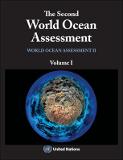Por favor, use este identificador para citar o enlazar a este item:
http://hdl.handle.net/10261/321598COMPARTIR / EXPORTAR:
 SHARE
BASE SHARE
BASE
|
|
| Visualizar otros formatos: MARC | Dublin Core | RDF | ORE | MODS | METS | DIDL | DATACITE | |

| Título: | World Ocean Assessment II, Chapter 01, Overall summary |
Autor: | Bebianno, María Joao; Calumpong, Hilconida; Chiba, Sanae; Evans, Karen; García-Soto, Carlos; Kamara, Osman Keh; Marschoff, Enrique; Mohammed, E. Y.; Ojaveer, Henn; Park, C.; Randrianisoa, Ylenia; Ruwa, Renison; Schmidt, J.O.; Simcock, Alan; Strati, Anastasia; Tuhumwire, J. T.; Vu, C.; Wang, J.; Zielinski, Tymon | Palabras clave: | world ocean assessment Centro Oceanográfico de Santander Medio Marino summary |
Fecha de publicación: | 21-abr-2021 | Editor: | United Nations Division for Ocean Affairs and the Law of the Sea | Citación: | The Second World Ocean Assessment. Volume I. (ed.). United Nations. New York. 2021. 570 pp: 3-35 | Resumen: | KEYNOTE POINTS 1. Understanding of the ocean continues to improve. Innovations in sensors andautonomous observation platforms have substantially increased observations of the ocean. Regional observation programmes have expanded, with better coordination and integration. 2. Some responses for mitigating or reducing pressures and their associated impacts on the ocean have improved since the first World Ocean Assessment. They include the expansion and implementation of management frameworks for conserving the marine environment, including the establishment of marine protected areas and, in some regions, improved management of pollution and fisheries. However, many pressures from human activities continue to degrade the ocean, including important habitats, such as mangroves and coral reefs. Pressures include those associated with climate change; unsustainable fishing, including illegal, unreported and unregulated fishing; the introduction of invasive species; atmospheric pollution causing acidification and eutrophication; excessive inputs of nutrients and hazardous substances, including plastics, microplastics and nanoplastics; increasing amounts of anthropogenic noise; and ill-managed coastal development and extraction of natural resources. 3.There continues to be a lack of quantification of the impacts of pressures and their cumulative effects. A general failure to achieve the integrated management of human uses of coasts and the ocean is increasing risks to the benefits that people draw from the ocean, including in terms of food safety and security, material provision, human health and well-being, coastal safety and the maintenance of key ecosystem services. 4. Improving the management of human uses of the ocean to ensure sustainability will require improved coordination and cooperation to provide capacity-building in regions where it is lacking, innovations in marine technology, the integration of multidisciplinary observation systems, the implementation of integrated management and planning and improved access to, and exchange of, ocean knowledge and technologies. 5.The coronavirus disease (COVID-19) pandemic is having a major effect on many human activities carried out in the ocean. The full implications of the pandemic on human interactions with the ocean are still to be fully assessed. | Versión del editor: | https://www.un.org/regularprocess/sites/www.un.org.regularprocess/files/2011859-e-woa-ii-vol-i.pdf | URI: | http://hdl.handle.net/10261/321598 | ISBN: | 978-92-1-1-130422-0 |
| Aparece en las colecciones: | (IEO) Libros y partes de libros |
Ficheros en este ítem:
| Fichero | Descripción | Tamaño | Formato | |
|---|---|---|---|---|
| WOA2_Chapter-01.pdf | Capitulo de libro | 614,74 kB | Adobe PDF |  Visualizar/Abrir |
CORE Recommender
Page view(s)
29
checked on 26-abr-2024
Download(s)
15
checked on 26-abr-2024
Google ScholarTM
Check
Altmetric
Este item está licenciado bajo una Licencia Creative Commons

